Microsoft Rolls Out The LED Carpet For PC Gaming

Software giant's Games for Windows event in San Francisco features first looks at titles like Civilization IV: Colonization and Call of Duty: World at War, as well as the latest cards and rigs from Nvidia, AMD, Toshiba and Alienware.
What happens when a corporate behemoth and its gaming geek entourage descend upon San Francisco hipster mecca the Dogpatch? We're guessing a lot of cognitive dissonance. That theory was put to the test Wednesday when Microsoft Games Studios rolled out the LED carpet at Dogpatch Studios for its PC gaming bash, "The Big Picture."
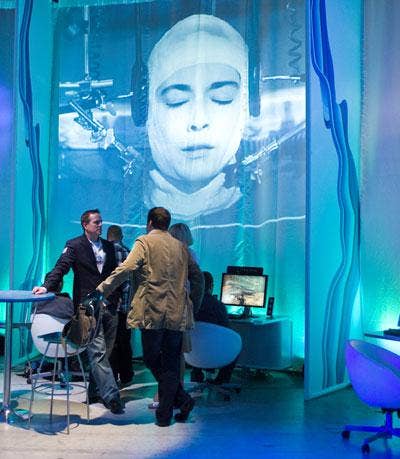
With the software giant's Games for Windows group playing host at the uberhip event space, game publishers, developers, system makers and hardware manufacturers demoed their latest and greatest gear for PC gaming. The resulting aesthetic discord—think 'roid-fueled commandos pillaging digital futurescapes amid avant-garde film shorts projected onto flimsy gauze strips—scans like some bizarre effort by Microsoft to wrestle the "Wii" out of "twee."

In keeping with the cinematic theme of "The Big Picture," the Games for Windows crew set up a full-service concession stand at Dogpatch Studios. Gamers were treated to everything from popcorn and pretzels to coffee and beer nuts as they queued up to play soon-to-be-released titles like Bionic Commando, Red Faction: Guerrilla and Call of Duty: World at War.

A sampling of the healthy snacks Redmond, Wash.-based Microsoft served up at its big PC gaming showcase. More than enough to get you through to the final levels of Space Siege or the Wall-E tie-in game, we reckon.
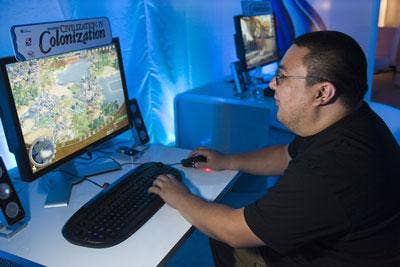
Neal Chung-Yee, a game analyst at New York-based 2K Games, demos Civilization IV: Colonization, the first PC addition to the Civilization franchise since last summer's Civ IV: Beyond the Sword expansion pack. Colonization, set to come out in the fall following the release of the first console version of Civilization, Revolution, is not a Civ IV expansion pack but rather a remake of the 1994 Microprose game on the Civ IV engine. Meanwhile, a mere 37 hours after this picture was taken, Chung-Yee had built a second tobacco plantation for his city.
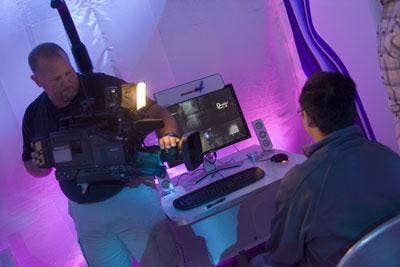
Taking pictures of people taking pictures of people is what these elite media gigs are all about. Seriously, though, the steady-cam rig this guy had was just as cool as all the new games and gear on display at "The Big Picture."

Kevin Unangst, who heads up Games for Windows at Microsoft, had a key message for the press: "We need to get away from the idea that PC gaming is dying." With a name like that, not to mention the job, you might think Unangst has to be the happiest guy in the world. But for the record, it's pronounced "yoo-nahngst."
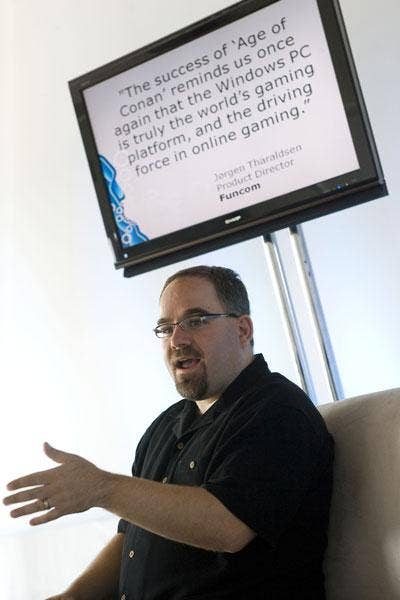
Want proof that PC gaming is going gangbusters? Unangst notes that global PC gaming revenue for 2007 totaled some $11.3 billion as compared to $14 billion for all consoles combined—not too shabby on its face. If you consider the PC as a kind of console itself, the Games for Windows director suggests, those numbers speak to a very healthy PC gaming industry despite some market-share loss to all the other consoles taken together.
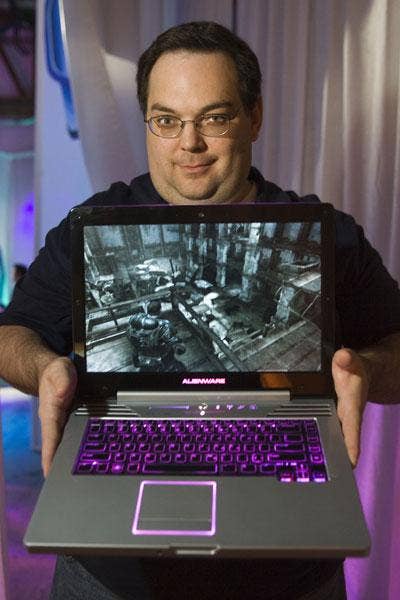
Dell's Eric Reichley, who works in the intriguing field of "Galactic Gaming Partner Relations," offers up Gears of War as handled by the Alienware M15X gaming laptop. Retailing for between $2,500 and $4,000, this mobile rig features Intel's top-of-the-line dual-core mobile processor, the Core 2 Extreme X9000, Nvidia GeForce 8800 GTX graphics, a 1,920 x 1,200 LED screen, a Blu-ray drive and five customizable lighting zones. Sure, it weighs in at a hefty 8 pounds, but mobility isn't the main selling point of a high-end system like the M15X.
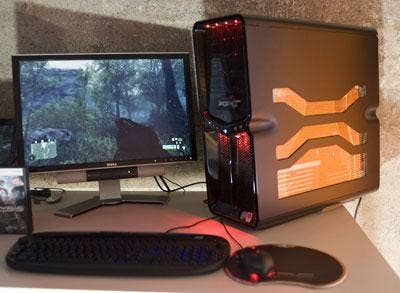
The Dell XPS 730 is an Alienware brainchild but for marketing purposes it's been stamped with the brand of the Austin, Texas-based parent company, according to Reichley. The 3.8GHz Core 2 Extreme QX 6850 quad-core CPU from Intel and a pair of Nvidia's 8800 GTX cards are more than enough to handle even ultra-demanding games like Crysis, according to the Dell pitchman. The XPS 730 has 4 GB of Dominator memory from Corsair Memory, sports Peltier, or thermo-electric cooling, and can be had in bottom to top configurations for between $2,000 and $5,000.
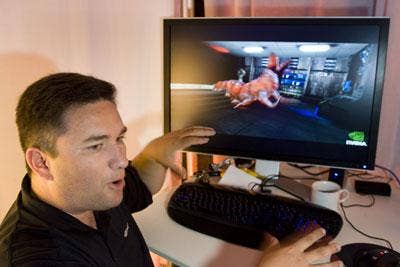
Tony Carrillo, a technical marketing engineer at Nvidia, explains the fine points of the graphics chip maker's PhysX software tools for game developers. The PhysX middleware SDK, acquired bySanta Clara, Calif.-based Nvidia in the February deal that netted AGEIA Technologies, lets developers build out from a host of GPU-optimized dynamical simulations driven by the realtime physics engine, without having to write their own code. These include a physics simulation of bunching or ripping fabric and, as shown here, a "soft bodies" application that gives gaming characters and objects flesh that actually responds realistically to being struck or to changes in the environment.
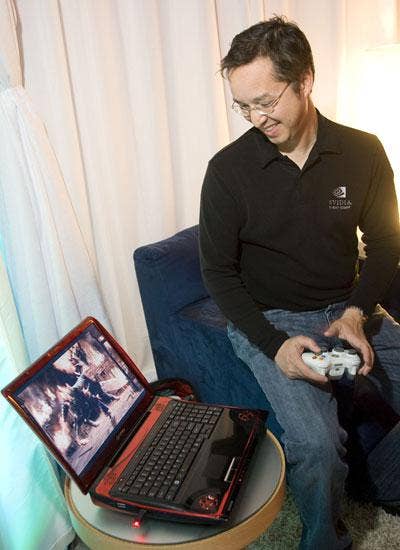
Nvidia PR rep Rick Allen gets his Devil May Cry IV on at the Microsoft Games for Windows showcase with this Qosmio X305 gaming notebook from Toshiba. Powering what you see on the 17.1-inch wide-screen TruBrite hi-def display is an Intel Core 2 Extreme processor, Nvidia's GeForce 9800M GTX GPU, a gigabyte of video memory, dual hard drives with 400 GB of storage and DDR3 RAM.
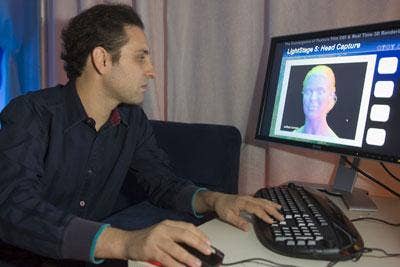
Jules Arbach of OTOY situates himself at the Advanced Micro Devices salon, where the graphics software developer was offering a peek at his mind-blowing realtime manipulation of enormous high-fidelity digital assets like Industrial LightMagic's Transformers robots.
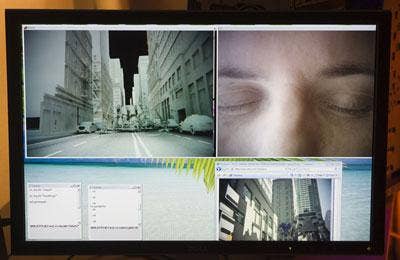
It's one thing to work realtime magic on robots and such and quite another to achieve cinema-quality visuals of the human face that can be manipulated within the near-instantaneous context of gaming, Arbach says. "Where all this is leading is, how do you get people to look real? It's the next frontier, and I think the hardware we have today is going to take us there. The convergence of this hardware and a little more work on the software side is going to make it happen," said the OTOY founder at AMD's recent Cinema 2.0 event in San Francisco.
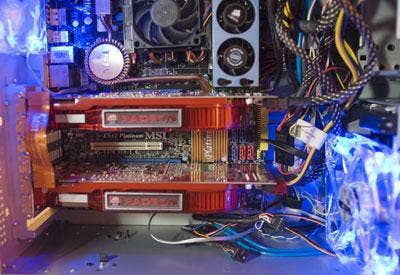
Maybe the craziest thing about the work Jules Arbach does is that he's doing it with hardware that anybody can afford. Well, maybe not anybody. The 2.6GHz Phenom 9950 quad-core powering Arbach's custom-built workstation won't even be available until Q3 and the ATI Radeon HD 4870 graphics cards—a pair of which are shown in this demo system, 10 of which are slotted into his real rig—were only released in limited quantities by AMD Wednesday. Still, it's a whole lot easier to imagine owning Arbach's system than having an ILM server farm at your fingertips.